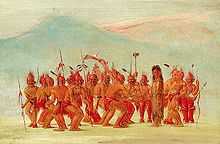Sex-androgyny in mythology
Ancient mythologies tell stories of androgyn archetypal beings, existing prior to the split in male and female.
Tantra

In Tantra, God, the unmovable Absolute, and Shakti, the sacred force or primordial cosmic energy are often depicted in a sexual embrace. Gross calls the Tantra-iconography nondual, when countering erotic interpretations of Tantra:
...a vital point must be made, especially given that the yab-yum image is always said to be an image in which the partners are in sexual union [...] [t]hough it may seem paradoxical and difficult to understand, this image, nevertheless, is not literally about sex, as in sexual intercourse. It is about nonduality, which is visually represented by the yab-yum icon.[1]
Plato's Symposium
In Plato's Symposium, Aristophanes tells of a primeval state of eternal bliss, which split into homosexuals, lesbians and heterosexuals:[2]
The original human nature was not like the present, but different. The sexes were not two, as they are now, but originally three in number; there was man, woman, and a union of the two [...] Terrible was their might and strength, and the thoughts of their hearts were great, and they dared to scale the heavens, and they made an attack on the Gods.
The Gods took council and Zeus discovered a way to humble their pride and improve their manners. They would continue to exist, but he cut them in two like a sorb-apple which is halved for pickling.
After the division, the two parts of man (the Androgyne), each desiring his other half, came together and throwing their arms around one another, entwined in mutual embraces, longing to grow into one; they were on the point of dying from hunger and self-neglect because they did not like to do anything apart; and when one of the halves died and the other survived, the survivor sought another mate, man or woman, as we call them--being the sections of entire men or women--and clung to that.
They were being destroyed when Zeus, in pity of them, invented a new plan. He turned the parts of generation round to the front, for this had not always been their position, and they sowed the seed no longer as hitherto like grasshoppers, in the ground, but in one another; and after the transposition the male generated in the female in order that by mutual embraces of man and woman they might breed and the race might continue; or if man came to man they might be satisfied, and rest, and go their ways to the business of life: so ancient is the desire of one another which is implanted within us, reuniting our original nature, making one of two, and healing the state of man.
Each of us, when separated, having one side only, like a flat fish, is but the identure of a man, and is always looking for his other half....and when one of them meets with his other half, the actual half of himself........the pair are lost in an amazement of love and friendship and intimacy, and one will not be out of the other's sight.[3]
Navajo

The Diné or Navajo peoples held an ideal that "all humans were spiritually androgynous":
...eighteenth- and nineteenth-century Navajo had a three-sex, multigender system that included the nádleehí, a "two-spirit" (bi-gender) person who had one of three anatomical birth-sexes (male, female, or androgynous), but was identified by a combination of masculine and feminine gender-attributes. Because Native Americans typically thought birth sex matured over time and defined gender primarily based on work preference, "two-spirit" people included non-dually sexed persons; born-males who adopted women's work, manners, and speech patterns; born-females who took up men's work and mannerisms; or those born either male or female who combined elements of women and men's cultural roles. Finally, the Navajo did not denounce the nádleehí as unnatural because gender or sex practices did not fit an individual's birth-sex; rather, they thought that all humans were spiritually androgynous, so they treated the nádleehí as a special but natural gender.[4]
Construction of gender-opposites
Modern medicine and genetics construct opposite sexes:
[O]ur culture defines our genetics, object-oriented genital joining, and other gender practices in binary fashion in order to identify us dualistically as either male/masculine or female/feminine [...] Only with the rise of Western medicine and genetics has sex been conceived as dual and ontologically stable—male and female.[5]
See also
References
- ↑ Gross, Rita M. (2009). A garland of feminist reflections: forty years of religious exploration. University of California Press. ISBN 0-520-25585-2, ISBN 978-0-520-25585-2. Source: (accessed: Friday April 23, 2010), p.207
- ↑ Connell O'Donovan, "Hen Ek Duoin": One Out of Two. Aristophanes' Speech from Plato's Symposium
- ↑ Plato, "The Symposium," Benjamin Jowet, trans., Great Books of the Western World, Chapter 7, page 157.
- ↑ Burrus 2006, p. 73.
- ↑ Burrus 2006, p. 71–72.
Sources
- Burrus, Virginia; Keller, Catherine (2006), Toward a theology of eros: transfiguring passion at the limits of discipline, Fordham University Press, ISBN 978-0-8232-2636-8